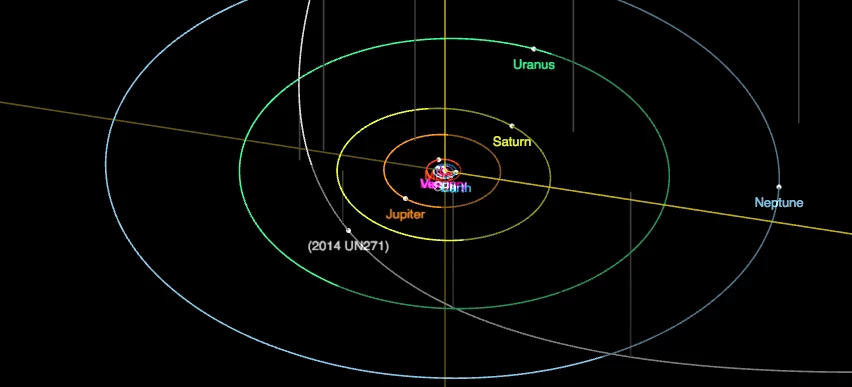An absolutely gigantic comet is currently barreling towards the solar system – and new observations have pinned down just how big it is. A team of astronomers has measured it to be about 150 km (93 miles) wide, making it comfortably the largest comet ever discovered. Other details about its orbit and coma are becoming clearer, too.
The comet is officially known as C/2014 UN271 Bernardinelli-Bernstein – the 2014 indicates the year it was technically first spotted, in data gathered by the Dark Energy Survey. However, it wasn’t identified until June 2021 by astronomers Pedro Bernardinelli and Gary Bernstein, after whom the object is now named.
Right away, the brightness of Comet BB indicated that it's large, at least 100 km (62 miles) across, but exactly how big it was remained murky. That’s mostly because it was observed at a distance of 29 Astronomical Units (AU) – almost as far away as Neptune – which is the greatest distance at which any comet has ever been discovered.
Now, further observations have narrowed down its size more precisely. A new analysis, led by Bernardinelli and Bernstein themselves, found that the comet nucleus is around 150 km wide, based on its brightness. If so, that makes it the largest comet ever discovered, by quite a margin. Most are only a few kilometers to several dozen kilometers wide, while some particularly big ones, like Hale-Bopp, may be up to 80 km (50 miles) wide. The previous record-holder, Sarabat’s Comet of 1729, has been estimated at about 100 km wide.
The team was also able to calculate the orbit of Comet BB in more detail. This object is on an incredibly long round trip into and out of the solar system – at its most distant point, some 1.5 million years ago, it was about 40,400 AU away. Last time it swung through our neighborhood was about 3.5 million years ago, when it came within 18 AU of the Sun.

But its current inward journey will be its closest so far. Astronomers have already calculated that in 2031, Comet BB will peak at 10.9 AU, almost reaching the orbit of Saturn.
Although very faint, the comet’s coma and tail have also been detected and studied. The new data suggests that carbon dioxide or ammonia is being vaporized off its surface according to simple sublimation thermodynamics.
Already, other scientists have detected outbursts of gas from the comet. Another team at Las Cumbres Observatory reported that it brightened considerably within a few hours on September 9.
While it’s hard to predict exactly what will happen in the future, the new study says that there’s a chance it might become much brighter than previously thought – up to magnitude 9, or a little dimmer than Saturn’s moon Titan. It was originally only expected to get as bright as Pluto. However, if a crust of water ice forms it might end up being a lot dimmer.
However it plays out, Comet BB will no doubt be an intriguing target for observations over the next decade and beyond.
The study has yet to be published, but it’s available on ArXiv and has been submitted to the Astrophysical Journal Letters.
Sources: Pedro Bernardinelli (Twitter), Ben Montet (Twitter), Astronomer’s Telegram




